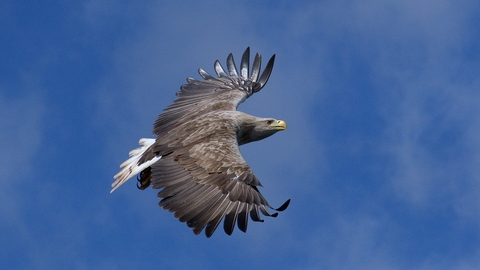When will White-tailed Sea Eagles be returned to Wales?
Gwent Wildlife Trust are working with Eagle Reintroduction Wales, a Durrell Wildlife Programme to return a small breeding population of White-tailed Eagles to Southeast Wales and the Severn Estuary in partnership with the Wildfowl and Wetlands Trust (WWT). This reintroduction is licenced by Natural Resources Wales. A licence will be submitted next spring 2025 in hope that we get the greenlight to start a five-year release scheme in the summer of 2026.

Jeff Smith
To date Gwent Wildlife Trust been involved with the following as a partner in this exciting project:
- More than 64 site visits to local landowners across SE Wales.
- 6 Community Workshops [175 participants]
- 4 community drop-in sessions [139 attendees]
- 67 one-on-one stakeholder meetings, discussion and training webinars have been facilitated.
- 49 White-tailed Eagle talks and events facilitated with an outreach of 5,560 people.
- Schools4Species programmes to connect youth groups with local wildlife now launched.
What is a White-tailed Eagle?
The White-tailed Eagle (Haliaeetus albibilla) is our largest bird of prey with a wingspan of eight foot and in flight it has long, broad ‘fingered’ wings. They are brown in colour with a pale head and neck which in adults can be almost white, along with a white wedge-shaped tail.
It is widely distributed across Europe and Asia with strongholds in Norway and Russia. Part of the Accipitridae family, this eagle is one of eleven other species known as Sea eagles. White-tailed eagles are also known as the White-tailed Sea eagle, Eryr y Môr in Welsh and sometimes it is known as the ern or erne. It is considered a close cousin of the Bald eagle (Haliaeetus leucocephalus) which occupies similar habitats in in North America and is very similar in behaviour
Are they native to Wales?
Yes, the British Ornithologists’ Union (BOU) recognises the White-tailed Eagle as a species which is native to the UK. The BOU maintains the UK list – an official list of wild bird records in the UK. This species is a ‘former breeder’.
White-tailed Eagles suffered intense human persecution, like many other birds of prey, which caused population extinction in Wales by 1830 and the wider UK landscape by 1918. Historic records such as place-names, archaeological, observational and historic persecution records showcase the birds were common and widespread across the UK. Historic information for Wales shows records in every county with the last known nest site located at Kenfig National Reserve on the Swansea coast in South Wales.
use historic maps here.
Where do they live?
White-tailed Eagles are part the Sea Eagle family (Haliaeetus) and are tied to freshwater and marine landscapes. You would most likely find a White-tailed Eagle around the shallow waters of our coastlines, rivers and lakes. Mature trees and woodlands are also important habitat for roosting and nesting White-tailed Eagles.
What do they eat?
As a generalist raptor over 1,000 prey items are found in White-tailed Eagle diets. An aquatic prey specialist targeting seasonally abundant prey, these birds favour fish, water birds and carrion, but can take a variety of other birds and mammals at a less regular capacity. The birds favour shallow waters as foraging grounds. The mosaic stretches of freshwater and marine habitats across Southeast Wales and the Severn Estuary provide perfect foraging grounds and are important habitats for migratory fish, waders, and waterfowl. Seasonally abundant fish species such as Grey Mullet and Northern Pike; and plentiful of ducks and geese such as Mallards, Coots, Wigeon, Canada geese, Greylag geese, Cormorants, Goosanders and Gull species are likely to form a key source of prey for White-tailed Eagles. It is thought that most geese and ducks taken by eagles are likely to be injured or sick individuals. The high concentrations of wintering wildfowl and waders in these regions mean that foraging eagles will regularly encounter carcasses washed-up dead as they search shorelines for food.
Why is it important to return them to Wales?
The White-tailed Eagle is listed as a Species of Conservation Concern in the UK and is recognised as a priority action for species recovery in the UK Government’s 25-year Environment Plan. This is advised to be best achieved by a rolling scheme of reintroduction programmes for the species in Britain. Our programme to restore White-tailed Eagles to the Severn Estuary is a recognised and accepted strategy for the UK conservation of this species. Any plans to restore the White-tailed Eagle to Wales would substantially aid regional, national and international efforts to restore the species to its historic ranges and contribute to the global species recovery programme. A Severn Estuary restoration will provide connectivity between Scottish (150+ pairs), Irish (12+ pairs) and English populations (1+ pair) and facilitate international links with small recovering populations in Europe (e.g., France, Spain, Netherlands).
Wales is now the only country in Britain not contributing to the national and/or international conservation recovery programme for the species. This conservation programme aims to provide an opportunity for Wales to take a progressive stance towards species and ecosystem restoration.
Why not wait for them to re-colonise naturally?
White-tailed Eagles are long-lived birds with delayed sexual maturity, low breeding success and slow range recovery. Birds do not breed until 4 or 5-years old and often choose breeding sites close to their original natal/nest sites, meaning that population expansion is extremely slow. Despite other projects in the UK working to restore White-tailed Eagles, it is thought it could take 50-100 years for birds to colonise Wales naturally. This reintroduction project would significantly speed up this process restore this native-lost breeding species into its former UK historic range.
